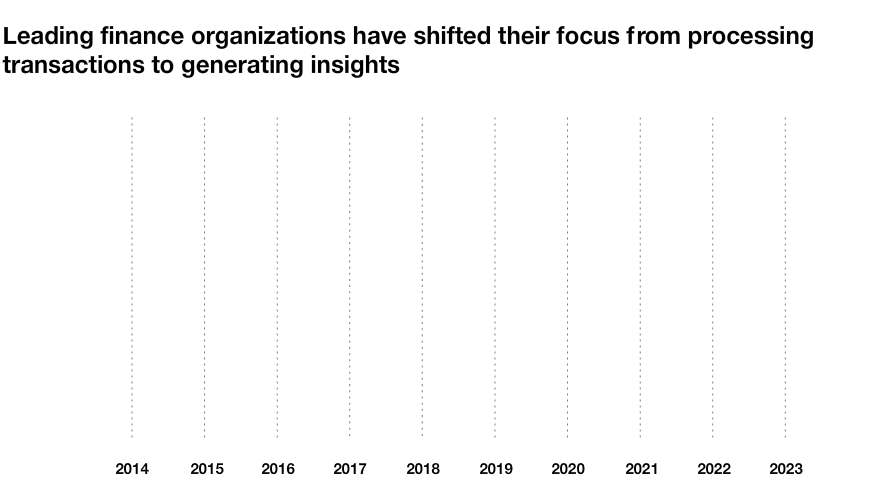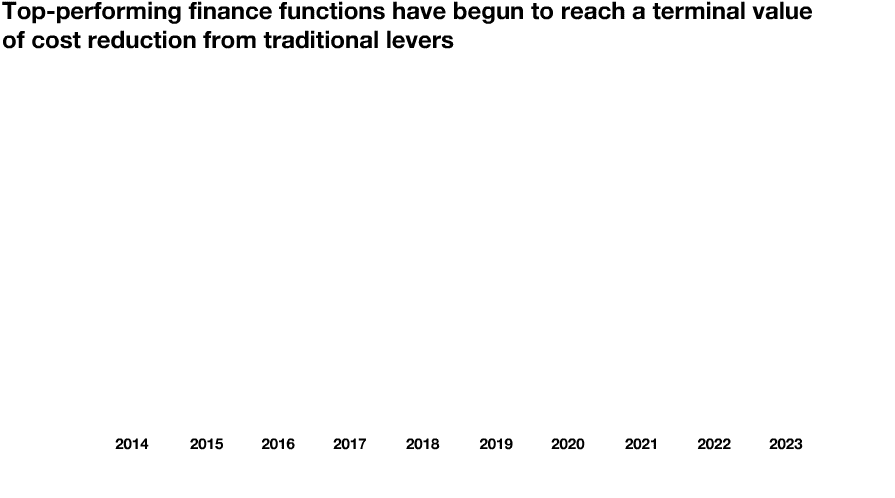

Responsible AI in finance: 3 key actions to take now
Learn how finance leaders can balance AI’s potential with governance, data integrity, accountability and reliable financial reporting.
Ask almost any finance leader, and they’ll say transformation usually focuses mostly on cost reduction — improving processes, automating transactions, reducing headcount and so on. That’s understandable. Over many decades, finance has implemented multiple layers of efficiency initiatives, from automating transactional processes to leveraging global business services (GBS) models.
While these measures have helped reduce costs, they’ve also led to a potential “terminal value,” with diminishing returns for many companies. This applies not only to traditional cost-cutting efforts but to finance’s value to its business partners as well.
For leading companies, the definition of finance transformation has expanded to focus on generating business insights, enabling business decisions and driving enterprise strategy. PwC benchmarking data from 2014 through 2023 shows this shift with top quartile finance functions spending more time on generating insights than automatable tasks for the first time in 2020. While this validates work to increase efficiency, it poses important questions: Have leading finance functions reached their terminal value and, if so, how can finance best add value to the organization?

Source: PwC Finance Effectiveness Benchmarking Study
It’s true that traditional cost-reduction measures have generally driven down the cost of finance as a percentage of revenue, with leading organizations now spending less than 0.8% of revenue on finance. But cost reduction has stalled as many companies have implemented the most available cost-reduction levers.

Source: PwC Finance Effectiveness Benchmarking Study
In fact, PwC benchmarking data shows that incremental cost reductions from these measures have begun to flatten for top-performing finance functions, which raises critical questions:
To enable more advanced capabilities and establish its value within your organization, finance should move beyond its traditional methods of transformation. This will likely require investing in new capabilities, driving a data strategy, upskilling people, and embracing nontraditional and new types of resources.
An “agentic organization” is now being discussed in which organizations can use intelligent, autonomous software agents to perform tasks and suggest outcomes traditionally handled by people — often orchestrating entire workflows across the enterprise. This enables humans to focus on strategy and creativity, serving as specialists in specific areas. It breaks down borders and boundaries with a hyper-distributed workforce, allowing finance teams to focus on insights and action.
As leading finance organizations approach their terminal value, the focus should shift to creating value through insights and driving the business strategy. This reflects the evolving role of finance as a strategic advisor to the business, providing real-time, data-driven insights that influence key decisions.
Finance functions are shifting toward a “finance for business” model, where time and effort are spent on internal and external business drivers that influence decision-making. Market trends, geopolitical factors, economic shifts and the like now have a role in CFO decisions, which also can uncover potential profit pools for the business.
To do this, finance teams are embracing advanced analytics, predictive models, AI — including ML and generative AI (GenAI) — and AI agents to:
This transition requires significant investment in technology, data and talent, with dollars once earmarked for efficiency initiatives now redirected to building capabilities that can generate insights. These investments also should help equip your finance workforce with the knowledge and skillsets to leverage these advanced tools, resulting in more proactive and strategic discussions with your stakeholders.
As automation, AI and AI agents take over repetitive processes, finance teams are freed from time-consuming manual tasks and can focus on higher-value activities. These can include forecasting future financial outcomes based on predictive models, analyzing market trends to inform investment decisions and assessing the impact of strategic initiatives through scenario modeling. As these models create multipliers for the human workforce, CFOs should shift their mindset from incremental change to helping the business bend the revenue and cost curves at a faster pace.
Automation can go beyond simple process improvement. By leveraging AI and ML, finance functions can continuously learn from data patterns and refine predictions, leading to better forecasting accuracy and a deeper understanding of business drivers.
Being able to automate transactional tasks while leveraging advanced analytics helps position the finance function as a proactive contributor to business strategy rather than a reactive processor of financial data.
While tech investments can enable the shift to insight-driven finance, they also come with a cost. For leading companies, the curve of cost reduction has flattened because investments in data infrastructure, AI/ML tools and advanced analytics are now required to generate value through insights. This reallocation of resources is essential for finance to evolve, but it also affects the finance function’s overall cost structure. In many organizations, the digital core that serves as the transaction engine still has technology and process debt that isn’t fit for purpose in changing times and should be addressed to leverage the benefits of data and AI.
For companies not yet at the forefront of adopting AI and other technologies, these innovations can help accelerate bending the cost curve. Organizations can unlock new efficiencies and insights, ultimately transforming their financial operations and gaining a competitive edge.
One paradox of reaching terminal value is that even as the cost of finance as a percentage of revenue has plateaued, further tech investments may temporarily offset some of the savings generated through traditional efficiency levers. Still, the ROI from new insights gained may very well exceed the cost savings from transactional process improvements.
The future-ready finance organization integrates real-time data, advanced analytics, AI/ML and scenario modeling into daily operations, allowing teams to not only monitor performance but predict and influence it. By embedding finance deeply within business processes, equipped with the right data and disruptive technologies, your company can be better positioned to ensure that financial insights are aligned with broader enterprise goals.
To transition your finance function from a transactional, cost-focused role to one that can drive strategic decisions, invest in these key areas.


Learn how finance leaders can balance AI’s potential with governance, data integrity, accountability and reliable financial reporting.


Learn how to transform into a leading finance function of the future in 2024. Leverage tech and data to power finance decisions that generate value.


PwC offers strategic finance transformation services and solutions to help businesses transform for the future of finance.


Unlock your digital transformation journey by prioritizing EPM, creating a seamless integration and maximizing the value of your ERP implementation.


A new finance playbook for strategic cost management, cost reduction, and cost optimization. Deliver business insights that protect profitable growth.